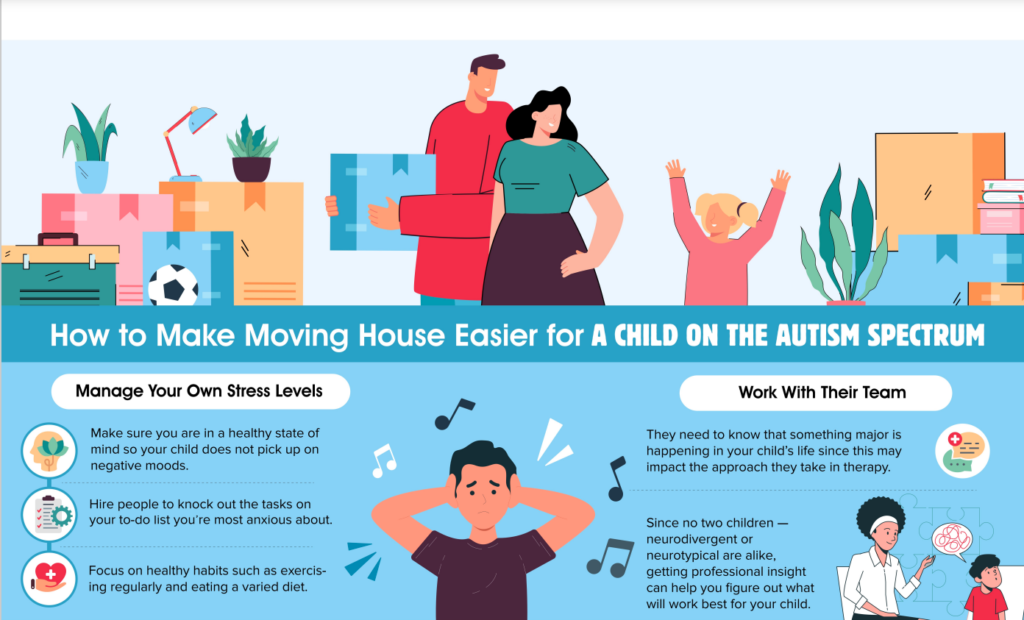In this article, Jenny Wise, a mother of an autistic daughter offers some tips which helped her on how to make moving house easier for a child on the autism spectrum.

Moving is a major change, and everyone can wind up experiencing stress, sadness, and other challenging emotions when faced with this kind of transition. For children on the autism spectrum, however, a move has the potential to be extremely distressing. Many autistic children thrive on routine and familiarity — anything that throws a wrench in that can leave them feeling totally destabilized.
Fortunately, there’s a lot you can do as a parent to make the transition smoother. Here are some tips which could make your move easier on your little one.
Manage Your Own Stress Levels
Moving isn’t just hard on kids. Adults have to manage the stress of finding a space, packing, organizing, and managing logistics — all while also undergoing the mixed emotions that come with settling into a new home. This means moving is, in many ways, a “give yourself oxygen first” situation. If your stress levels are through the roof in your move, your children are bound to pick up on that and be more anxious, too. Moreover, it will make it much harder for you to connect with your little ones and help them use coping tools to ease their transition.
There are several ways you can keep yourself less stressed during a move. For example, you can hire people to knock out the tasks on your to-do list you’re most anxious about or just have no time for, such as furniture cleaning. Getting a pro with all the right tools to manage these kinds of jobs on your behalf can be a major load off. But do make sure to check any furniture warranties, as well as compare quotes, references, and guarantees from various services. Dedicating a weekend to throwing out or donating clutter around your house can also make your move simpler and home tidier.
Finally, focus on healthy habits such as exercising regularly and eating a varied diet. These things often fall to the wayside during a move. However, committing to them can make you far less vulnerable to move-related stress.
Work With Their Team
As with any major transition, it’s best to work with your child’s medical and therapeutic team when preparing for a move. There are several reasons for this. First and foremost, they need to know that something major is happening in your child’s life since this may impact the approach they take in therapy. This gives them the chance to help your child build coping tools specific to the transition, making things easier on everyone.
Moreover, they may be able to give you tools and skills, as well. For example, they may have advice on the best ways to introduce your child to their new home or be able to give you a sense of what kinds of moving-related responsibilities you can give your little one so they feel truly involved. Since no two children — neurodivergent or neurotypical — are alike, getting professional insight can help you figure out what will work best for your child.
If your child is old enough to express their opinions about their space, then put them in charge of decorating their new room. This can be an absolutely essential step for helping them feel involved in the process and at home in the new space. Plus, it gives them a chance to build self-identity and explore their own interests and tastes.
Although you may be tempted to lead them through the process, make an effort to let them be in charge. Remind them they can ask for help, and let them know you may have to veto ideas that aren’t feasible. Otherwise, let them take the reins so that they can create a space that’s totally their own.
When picking out a house, you may want to consider an “as-is” home so you can tailor the property to meet your child’s needs and desires. Since “as-is” homes are typically less expensive, you could use the money you saved to needs-based changes to the home and property — as well as their bedroom!
Remember, doing everything right doesn’t mean that moving won’t be hard on your child. Transitions like these are inherently challenging. However, you can give your child tools to help them handle those challenges more effectively, making their transition smoother, faster, and easier.

______________________________
If you need support in getting a specialist independent placement for an autistic child or young adult, we can help. Click below for our Autism Schools and Colleges Placement Support Service.



